Comment on West Point Defense & Strategic Studies “War Council” Series
Iran is in the headlines every day. The new Iranian President, Hassan Rouhani, has raised the possibility of diplomacy with the United States, providing hope for a deal on the nuclear front. At West Point, in class, instructors find cadets asking pointed questions about what American military intervention might look like. Many of these teachers, in turn, are talking about the issue.
In this context, the Defense & Strategic Studies Program at West Point organized a multi-disciplinary, academic and professional forum on 4 October 2013, to discuss the many perspectives on potential American military intervention in Iran. The panelists each commented on Iran within their area of expertise, and what follows is the set of edited, written remarks from the event (provided by each panelist). Each view is important, particularly to cadets personally grappling with these real world issues for the first time.
Some have questioned such a panel for cadets. One officer/faculty member who exemplifies this attitude said this past April, “we don’t want second lieutenant strategic thinkers [in the United States Army].” Unfortunately, this is not a new argument on the Hudson River; Superintendent Major General Samuel Koster advanced the idea in 1970, that at West Point, “We’re more interested in the ‘doer’ than the ‘thinker’.” Fortunately, the leadership in today’s Army thinks differently. Chief of Staff General Raymond Odierno has recently written that, “[Today’s environment] demands leaders with the ability to think broadly and critically, aware of the cultural lenses through which their actions will be viewed and cognizant of the potential strategic ramifications of their decisions.”
In short, this type of event has merit because, upon graduation and subsequent entrance into the profession of arms, each one of these cadets must be able to relate their tactical actions to American national policy. We are not after strategists or strategic planners, per se, but officers with strategic understanding. It is critical that all know the context in which they serve and where they fit within the military instrument of American national power, because as commissioned officers all will directly contribute to the nation’s strategic performance in war.
**The views expressed in this article are those of the authors alone and do not reflect the official policy or position of West Point, the Department of the Army, Department of Defense, or the U.S. government.
****EVERYTHING THAT FOLLOWS: REMARKS FROM THE ACTUAL EVENT****
4 October 2013 - Event Introductory Remarks (Captain Andrew Betson)
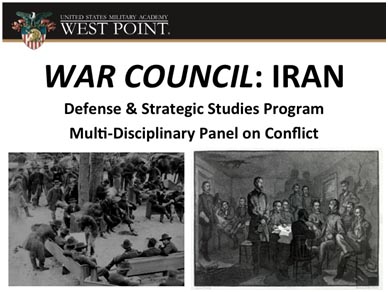
Good afternoon, ladies and gentlemen. On behalf of the Defense and Strategic Studies Program, the Department of Military Instruction, and our panelists, welcome to the second DSS War Council, “Denying the Bomb: American Military and Foreign Policy Options towards Iran.” We have gathered this War Council for both an academic and professional purpose – to discuss the utility of American force to deny Iran the bomb.
Questions abound. Why do we have such a poisonous relationship with the Iranians? How far along are they in developing a nuclear weapon? What approaches have we tried apart from military force? And, ultimately, what might we consider about the use of force - can this approach be effective? Is it wise to try?
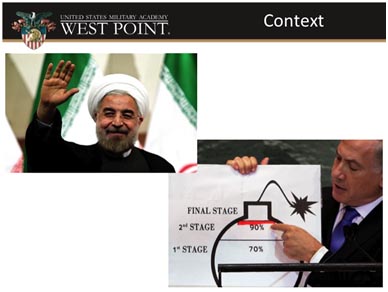
Some context will inform our discussion. Just over a year ago, on 27 September 2012, Israeli Prime Minister Benjamin Netanyahu famously “drew a red line” on the floor of the UN General Assembly to express his country’s concern over Iran’s nuclear program. On June 15th of this year, Hassan Rouhani was elected President of Iran, assuming office on August 3rd. The international community anticipated his remarks at the 68th Session of the UN General Assembly with baited breath, hoping that the new Iranian President would open a door for rapprochement. Optimism abounded as Secretary John Kerry and his Iranian counterpart met in the highest level meeting between the states since the 1979 revolution.
Over the last week, optimism has turned to concern. Three days ago, Prime Minister Netanyahu, in the 6th minute of his General Assembly speech stated “[Former President] Ahmadinejad was a wolf in wolf’s clothing. Rouhani is a wolf in sheep’s clothing.” The new president later refused to attend an opportunity to appear with President Obama. Finally, while the Iranian and American Presidents spoke on the phone, leaders in the Islamic Revolutionary Guard Corps publicly criticized Rouhani for doing so.
Today we are considering options related to preventing Iran from gaining nuclear capabilities. We cannot ignore, however, that since 2007, five nuclear scientists and the head of Iran’s ballistic missile program have been killed. Furthermore, two days ago, the Iranian Cyber Warfare Commander was murdered.
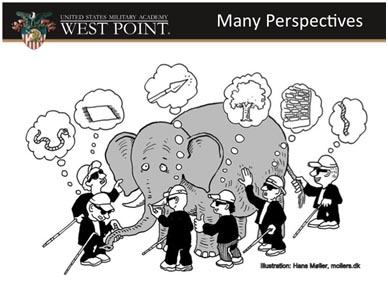
Many describe going to war as “seeing the elephant.” We in DSS extend that metaphor. Think of the Indian proverb about the blind man touching the elephant. There are many perspectives, each necessary but not sufficient on their own. Similarly, we’ve gathered a multi-disciplinary panel of experts, in one place, to help you see the conflict from many angles. In the interests of time, I’ll very briefly introduce the order of march by topic:
- Historical Background
- Nuclear capability
- Social Cultural Considerations
- Regional Diplomacy
- Cyberwarfare Considerations: LTC David Raymond of the US Army Cyber Center, and Electrical Engineering and Computer Science Department
- Military Strategic Considerations: MAJ Matt Cavanaugh of DSS
Last point, before we begin: this is both an academic and a professional exercise; we are not here to criticize the administration or voice political opinion. The Council of War tradition is old – and the old rules apply. Generally, so do Vegas rules: what happens in War Council stays in War Council. This is non-attribution, so no direct quotation without expressed permission. The views expressed by the panelists are theirs alone – and do not represent in any way those of the U.S. Government, Department of Defense, the Army, or West Point.
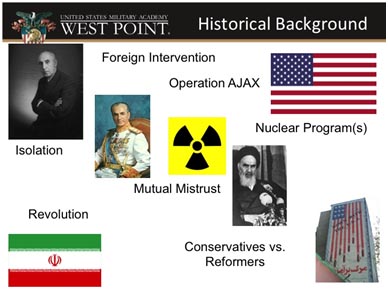
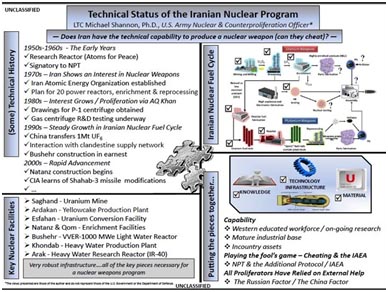
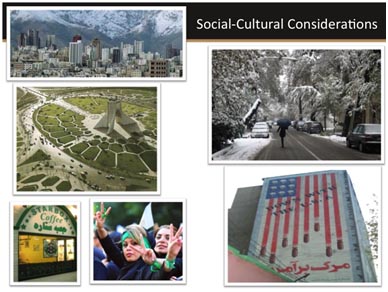
Cyber War (LTC David Raymond, PhD)
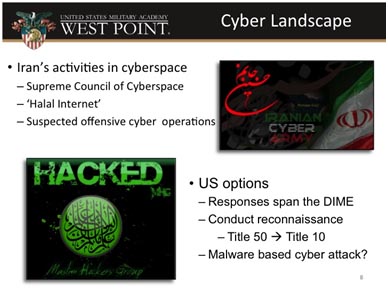
US efforts to derail Iran's nuclear program have provided them ample motive to "even the score." Crippling economic sanctions championed by the United States are touted by Iran as an attempt to stop their peaceful nuclear power program and suspected US involvement in the development of the Stuxnet virus and other malware, seemingly designed to destroy uranium centrifuges, are certainly viewed by Iran as attacks on their sovereignty. While Iran has neither sufficient international support, nor military capability, to respond using conventional means, they surely see cyber operations as an effective asymmetric avenue to cause harm to the United States and our allies.
The long-term wave of Denial of Service (DoS) attacks against U.S. financial institutions is an example of this type of cyber attack. Traditional DoS attacks mounted by cyber criminals and hacktivists are usually mounted for a few hours at a time, leveraging compromised personal computers, and are relatively easy to mitigate. These new attacks are different. An almost constant onslaught of DoS attacks have targeted the U.S. financial sector, including Bank of America, Chase, Citigroup, Wells Fargo, HSBC, Capital One, PNC, US Bankcorp, and BB&T, for over a year. These attacks have leveraged compromised servers in large data centers, increasing their effectiveness by an order of magnitude. A Muslim hacker collective known as Cyber Fighters of Izz ad-Din al-Qassam have claimed credit, however, the level of sophistication of the campaign has convinced U.S. government agencies that the attacks are the work of a nation-state actor, and a combination of technical and circumstantial evidence points to Iran[1]. Iran denies involvement, highlighting the difficulty of attributing cyber operations to a specific organization or country. Fortunately, we are finding better methods for identifying the source of cyber attacks. However, proving attribution to the international community, especially when most of the evidence is gathered through highly classified programs, is much more difficult, leaving the attacker room for plausible deniability.
Other possible evidence of Iran's efforts in this area is the August 2012 cyber attack on Saudi Aramco, the world's most valuable company. On 15 August 2012 the Shamoon virus was unleashed, which erased data on three-fourths of their corporate PCs, destroying emails, documents, spreadsheets, and other files and replacing them with an image of a burning American flag. A Muslim hacker group, the Cutting Sword of Justice, claimed credit for the Shamoon virus. Again, security experts are largely in agreement that this sophisticated malware is the work of a state sponsored group, most likely backed by Iran[2]. Why would Iran target Saudi Aramco? The company planned to increase oil production to make up for the dip caused by international sanctions on Iran's oil sales, a move that Iran repeatedly warned them against
Just this week the Wall Street Journal reported that US officials claim that Iran has penetrated the U.S. Navy's unclassified intranet[3]. If true, this is a significant escalation of both their capabilities and their willingness to take overt steps in this domain.
Iran has been quickly increasing its capabilities in cyberspace, claiming to have the 'fourth biggest cyber power among the world's cyber armies' and allocating up to $1B dollars to acquire and develop technology and to recruit and train experts[4]. In March 2012, Iran created the Supreme Council of Cyberspace, chaired by the Ayatollah Khamenei, to manage the country's cyber policies. The group will carefully regulate use of the Internet, largely through content filtering by the Committee in Charge of Determining Offensive Content (CCDOC) and by coordinating efforts by the Iranian Revolutionary Guard Corps (IRGC), the Ministry of Intelligence and National Security, the Ministry of Culture and Islamic Guidance, and others to manage Iran's cyber defense[5]. Clearly influenced by the Green movement and the Arab Spring, Iran has been working to shift all of Iran to their "Halal Internet", with which they hope to control the message by blocking content with which they disagree and by directing Internet searches to state-sponsored resources. This sort of control has always been difficult; as John Gilmore of the Electronic Frontier Foundation once said, "The Net interprets censorship as damage and routes around it." But by controlling the routers by which content enters Iran, and with help from partners such as China, this effort could be more successful than others.
Iran still has a ways to go in cyberspace to match the capabilities of the major players such as the US, China, and Russia, however, their ability to recruit middle-eastern cyber experts by leveraging ill-will against the West could help them tremendously. Furthermore, cyberspace can provide an asymmetric battlefield. A small group of skilled cyber operators can take down large networks. While Iran doesn't currently seem to have the capability to create a significant cyber event, the potential for them to do so in the future is there.
The US has various options in cyberspace. Improved information sharing between government and private sector entities will help US banks as they continue to use technical means to reduce the impact of DoS attacks against their infrastructures. These defenses are costly, but are generally effective over time. Continued diligence by the National Security Agency and others in the intelligence community to identify terrorist and other threats continues to improve our homeland security posture. The DoD sees cyber operations as another collection of capabilities to be integrated into the targeting process that can be used alone or in conjunction with kinetic means to influence an adversary.
We may already have an electronic presence in Iran's networks. If not, developing such a foothold is time consuming and we should start now. US policy states that intelligence assets operating under Title 50 authorities can set the conditions for future offensive cyberspace operations through detailed reconnaissance of adversaries' networks. Transitioning to offensive operations would require the President or Congress exercising Title 10 authorities, but once an electronic presence is established, such action can be taken rapidly.
Mounting a Stuxnet-like attack on Iran's nuclear ambitions is another matter. Speculation continues that the US was at least partially responsible for the Stuxnet virus, and its successors, Duqu and Flame. Regardless of who created it, Stuxnet was almost certainly designed to specifically target industrial control systems (ICS) controlling uranium centrifuges at the Natanz nuclear enrichment facility in Iran. Malware of this complexity likely took months or years and hundreds of thousands of dollars to develop, and Iran has certainly increased its defenses against this sort of cyber attack. Any such future effort would likely require a larger investment of both time and money, and would have lower probability of success.
Military-Strategic Considerations (MAJ Matthew Cavanaugh)
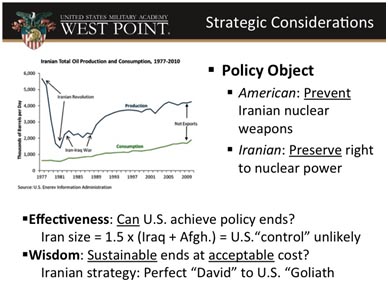
Academics and opinion writers engage military issues all the time – glossing over important considerations. For example, Washington Post columnist Charles Krauthammer, last year, writing on the U.S. Navy breaking an Iranian blockade in the Straits of Hormuz: “We will succeed, but at considerable cost.” That seven-word sentence is pregnant with so many assumptions, challenges, paradoxes and questions – it is just so amazingly simplistic.
So what is a member of the profession of arms to think?
That’s why we’re here – to get beyond overbroad statements to real strategic analysis. I’ll cover three topics: what each country wants, likelihood of military tactical and operational effectiveness, and the strategic wisdom in using military force to deny the Iranian bomb.
Value of the Object
Start with a basic question – what do both sides want? Or, as Clausewitz puts it: what is the “value of the object?”
This is simple cost-benefit analysis, and both sides want access to energy.
For the United States, it is access to oil at stable prices.
The U.S. imports 19% of its oil from Gulf countries (Saudi, Iraq, etc.), about the same as what it gets from Canada. (U.S. Energy Information Administration, 2007 figure)
There are significant changes happening right now which reduce the value of Middle Eastern oil to the United States. Time magazine recently called it a “power revolution” – yesterday (3 October 2013), The Wall Street Journal declared that the U.S. has overtaken Russia as the world’s largest producer of oil and natural gas.
Therefore, over time the value of this object to America will decline.
For Iran, they want the ability to extract wealth – get cash – from oil.
Oil accounts for roughly 80% of exports from Iran and pays for 60% of government revenues. (US Energy Information Administration, 2009 figure)
New financial sanctions imposed on Iran in February have nearly cut in half (44%) their monthly earnings from crude oil exports. (Business Insider & AP)
Object to the Iranians is access to sustainable, energy wealth.
Let’s look to the chart provided in the slide, on the left. Here’s where the nuclear program comes in: since the Revolution – population and consumption has doubled (bottom line), while production has flatlined (top line). The space between these two lines – think of that as the amount of cash Iran can get out of oil – it has gotten much smaller. Rationally, Iran seeks other energy sources (nuclear) to reduce domestic oil consumption – and keep the space between these two lines bigger – so they can sell their oil abroad for money.
Something must change for the Iranians; the U.S. prefers the status quo.
Policy – in sum:
US: Prevent Iran from acquiring a nuclear weapon.
Iran: Ayatollah Ali Khameni – “Iran’s only demand [is] recognition of its right to enrich uranium for peaceful purposes.” (Akbar Ganji, “Who is Ali Khamenei?” Foreign Affairs)
Military Effectiveness
Can the U.S. accomplish this “prevention” policy militarily?
Let’s start with geography.
Iran = 50% larger than Iraq and Afghanistan put together.
Iran is about 25% larger than Iraq/Afghanistan populations put together.
(Economist World in Figures 2013, 2010 figures)
Let’s consider the last step before our first.
Think about landpower – stability operations – “Phase IV” – and base our force to population calculation off of historical examples.
There are about 75 million people in Iran.
Think of the French in Algeria.
For the U.S. to equal the French force to Algerian population ratio – that would take 4.5 million soldiers.
To equal the British in Malaya – 1.9 million soldiers.
And, by far, the most permissive environment historically, post WWII Germany – less than one tenth what the international community put into the Balkans – that would mean 165,000 soldiers. (Based off ratios in Steven Goode, Parameters, Winter 09-10)
There were about 165k U.S. forces deployed at the height of the Surge in Iraq. (Petraeus SWJ “Reflections” article)
So the lowest figure, the most permissive environment, would equal our recent maximum output – and at the same time that we’re shrinking the Army!
This simple force to space analysis suggests that the U.S. does not have sufficient landpower to control Iran to the extent required to deny a nuclear weapons program. And, note, I haven’t even gotten to a more detailed terrain analysis, partially out of time considerations, but also because I want you to be able to sleep tonight!
Wisdom
Wisdom – is it wise to use military force to deny Iran the bomb? How does one define “wise?” I’ve thought a lot about this point. I consider it to be the achievement of sustainable ends at an acceptable cost.
Much international relations theory focuses on material factors and assesses that the U.S. could (and would) mop the floor militarily with Iran.
Because they’re so small: Iran’s GDP is less than that of the City of London, the state of Austria, Massachusetts. Their military expenditures less than 2% of the United States (Karim Sadjadpour, Carnegie Endowment at Intelligence Squared, 25 February 2011)
But relative size advantage only takes us so far – how you use your resources – military strategy and force employment – matter greatly.
Iranian military strategy is irregular and low cost – designed to exhaust and erode.
So what specific course of action might the Iranians adopt?
Iran: could impose their own version of economic sanctions.
Close the Gulf – “naval guerilla warfare.” Let’s return to geography: the Persian Gulf is a “lake” – it is narrow, very shallow, and Iran has a 1,000 mile coastline that can provide cover and concealment to Iranian small boats and shore based anti-ship missiles. They have “tailored [their] naval strategy to maximize [their] advantages” in this environment (SWJ, Cummings).
The scholar Thomas Schelling, in his book Arms and Influence, wrote: “military force can be used to hurt…it can destroy value…the power to hurt is bargaining power.”
Neither side appears to be able to gain control – like two boxers with no knockout punching power – this will devolve into a punishment-resilience cycle. It also means that American strategy will have to be cumulative, which requires patience – because we can never know which straw will break the camel’s back.
Two last thoughts.
Although Clausewitz counsels me to be wary of reasoning by ancient history, I can’t help myself. Many of you are familiar with Steven Pressfield’s book Gates of Fire and the story of the Spartans at Thermopylae.
Briefly, in 480 BC a massive multinational force, somewhere between 70,000 and 300,000 soldiers, led by the Persians under Xerxes – invaded the “Western” world – they were thwarted at a geographical choke point by a significantly smaller (but determined) force of approximately 7,000 – which protracted the war long enough to give rise to a powerful domestic response.
In many ways, to consider military action against Iran bears some resemblance to Thermopylae – only this time, the “West” with the U.S. in the lead – invades toward another choke point, playing into the cost-imposing strategy of a smaller set of determined defenders well prepared to maximize the advantages the earth has given them.
It is hard to imagine the United States could use military force to sustainably deny the Iranians the bomb at a cost acceptable the American people.
Finally, I have to remind you that there is no objectively right or wrong assessment here – this is not black and white. Think of two approaches to hitting in baseball. Classic slugger (Sammy Sosa) versus a slap hitter like Ichiro Suzuki. Swing for the fences – huge payoff but high cost in strikeouts. Contact hitting – less immediate payoff but also less costly. Both approaches provide value and contain risk. (Stephen Biddle, “Conversations with History,” 17 April 2006)
The strategist’s task is to “lay bare” the benefit and costs of these choices, and try to dispassionately assess risk. (Stephen Biddle, “Conversations with History,” 17 April 2006) That is what I hope I have done for you today.
You should know, I’m very proud that you’ve chosen to be here. In the famous line from the second Godfather – “…this is the business we’ve chosen…” – the profession of arms; to study the use of force – and I’m excited that so many of you recognize that.
That said, thank you for your time and I look forward to your questions.
Biographical Information
Captain Andrew Betson is a US Army Armor officer assigned to the Defense & Strategic Studies program, Department of Military Instruction at West Point. He served two years in Operation Iraqi Freedom and holds a Bachelor of Science from the United States Military Academy and a Master’s in Diplomacy and International Commerce from the Patterson School at the University of Kentucky. Captain Betson’s next assignment will be as a student at the Command and General Staff School in Ft. Leavenworth, KS.
Major Matthew Cavanaugh is a FA59 (Army Strategist), currently assigned to teach military strategy in the Defense & Strategic Studies program at West Point. He served two years in Operation Iraqi Freedom and holds a Bachelor of Science from the United States Military Academy and a Master’s in Strategic Studies from Victoria University (New Zealand). Major Cavanaugh is currently at work on a PhD dissertation on generalship under Professor Colin S. Gray at the University of Reading (United Kingdom).
[1] N Perlroth and Q Hardy. (2013, January) Bank Hacking Was the Work of Iranians, Officials Say. [Online]. http://www.nytimes.com
[2] N PerlRoth. (2012, October) In Cyberattack on Saudi Firm, U.S. Sees Iran Firing Back. [Online]. http://www.nytimes.com
[3] J Barnes and S Gorman. (2013, September) U.S. Says Iran Hacked Navy Computers. [Online]. http://online.wsj.com
[4] AhlulBayt News Agency. (2013, February) Iran Enjoys 4th Biggest Cyber Army in World. [Online]. http://abna.ir/
[5] Iran Media Program, University of Pennsylvania. (2013, April) The Supreme Council of Cyberspace: Centralizing Internet Governance in Iran. [Online]. http://www.iranmediaresearch.org/
About the Author(s)
Comments
When I read or view presentations such as these by our American military I'm always surprised at how little they seem to know of Iran's true geopolitical perspective and defense related posture.
There is an excellent source in gaining an understanding on the subject put forth using an empathetic approach by former U.S. National Security officials Flynt and Hillary Mann Leverett, in their book "Going to Tehran." It should be required reading for U.S. military cadets and officers intent on furthering their knowledge of U.S.-Iran relations and implications for the U.S. military.
Really, for U.S. military purpose, approval or disapproval of their foreign policy advocacy is beside the point. What's relevant is their understanding of Iran's defense orientation, requirements and strategy.
Identifying media pundits such as Krauthammer as unsatisfactory might be correct but it would be much more helpful to encourage cadets to seek out more qualified sources such as the Leveretts.
